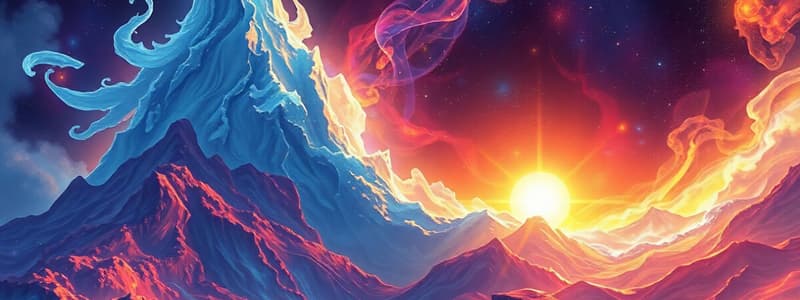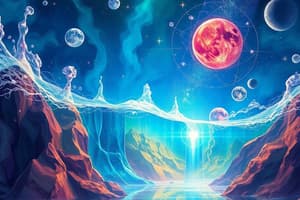Podcast
Questions and Answers
Which of the following conditions increases the rate of evaporation?
Which of the following conditions increases the rate of evaporation?
- Lower temperatures
- Smaller surface area
- Increased wind speed (correct)
- Higher humidity levels
What happens to the average kinetic energy of remaining particles in a liquid when evaporation occurs?
What happens to the average kinetic energy of remaining particles in a liquid when evaporation occurs?
- It remains constant
- It fluctuates randomly
- It decreases, cooling the liquid (correct)
- It increases, causing the liquid to heat up
In a longitudinal wave, how do the particles of the transmitting medium move?
In a longitudinal wave, how do the particles of the transmitting medium move?
- In back-and-forth motion parallel to the direction of wave travel (correct)
- Only in one fixed position
- Perpendicular to the direction of the wave travel
- In circular paths
What is the relationship between wave speed, frequency, and wavelength?
What is the relationship between wave speed, frequency, and wavelength?
Which of the following types of waves travel the fastest in a vacuum?
Which of the following types of waves travel the fastest in a vacuum?
What happens to light when it travels from a less dense medium to a more dense medium?
What happens to light when it travels from a less dense medium to a more dense medium?
What occurs at the critical angle in the context of refraction?
What occurs at the critical angle in the context of refraction?
Which of the following correctly describes total internal reflection?
Which of the following correctly describes total internal reflection?
What is the primary advantage of optical fibre cables over copper cables?
What is the primary advantage of optical fibre cables over copper cables?
What is the definition of reflection of light?
What is the definition of reflection of light?
What happens to gas pressure when the temperature of the gas increases while the volume remains constant?
What happens to gas pressure when the temperature of the gas increases while the volume remains constant?
What is the primary reason that solids maintain a definite shape?
What is the primary reason that solids maintain a definite shape?
Which statement best describes the process of boiling for a pure liquid?
Which statement best describes the process of boiling for a pure liquid?
What is absolute zero and its significance in thermal physics?
What is absolute zero and its significance in thermal physics?
What describes the movement of atoms in a liquid state?
What describes the movement of atoms in a liquid state?
How does increasing pressure affect the volume of a gas, assuming temperature is constant?
How does increasing pressure affect the volume of a gas, assuming temperature is constant?
What defines Brownian motion in the context of thermal physics?
What defines Brownian motion in the context of thermal physics?
What happens to the kinetic energy of particles when the temperature of a substance decreases?
What happens to the kinetic energy of particles when the temperature of a substance decreases?
Flashcards are hidden until you start studying
Study Notes
States of Matter
- Solid: Atoms are tightly packed, arranged in a fixed order. Only vibration and rotation around a fixed position occur.
- Liquid: Atoms are close together but can slide past each other.
- Gas: Atoms are far apart, move freely and randomly.
- Solids: Have a defined shape and volume, cannot be compressed.
- Liquids: Take the shape of their container, have a defined volume.
- Gases: Have no fixed shape or volume, can be easily compressed.
Change of States
- Solid to Liquid (Melting): Heat energy causes atoms to vibrate faster, overcoming forces holding them together.
- Liquid to Gas (Evaporation): Heat energy allows molecules to escape from the liquid's surface.
- Gas to Liquid (Condensation): Cooling causes molecules to slow down, allowing them to bond and form liquid.
- Liquid to Solid (Freezing): Cooling slows down molecular motion until they lock into a fixed pattern.
Force and Gas Pressure
- Temperature and Pressure: Higher temperature increases kinetic energy, making molecules collide with walls more often and with greater force, leading to higher pressure.
- Pressure, Volume, and Temperature:
- Constant volume, increasing temperature leads to increased pressure.
- Constant pressure, increasing temperature leads to increased volume.
- Inverse relationship: Increase in pressure means decrease in volume, vice versa.
- Boyle's Law: P1V1 = P2V2 (Relationship between pressure and volume at constant temperature).
Brownian Motion
- Description: Random movement of suspended particles in liquids or gases.
- Explanation: Collisions between particles and the molecules of the surrounding medium cause the movement.
- Evidence: Provides evidence for the kinetic particle model of matter.
Specific Heat Capacity
- Definition: The amount of energy required to raise the temperature of 1kg of a substance by 1°C.
- Units: Joules per kg °C (J/kg°C)
Boiling
- Definition: The process where a pure liquid changes to a gas at a specific temperature called its boiling point.
- Characteristics: Bubble formation within the liquid, containing the gaseous form of the substance.
Evaporation
- Definition: The process where energetic molecules near a liquid's surface escape into the gas phase.
- Occurs at all temperatures: Slower at lower temperatures, faster at higher temperatures.
Factors Affecting Evaporation
- Temperature: Higher temperatures lead to faster evaporation.
- Surface Area: Larger surface area allows more molecules to escape.
- Wind: Moving air carries away evaporated molecules, speeding up evaporation.
Cooling by Evaporation
- Mechanism: When evaporation occurs, the remaining liquid molecules have lower average kinetic energy, leading to cooling.
- Example: Sweating cools the body as sweat evaporates from the skin.
General Properties of Waves
- Transverse Waves: The disturbance travels perpendicular to the direction of wave propagation.
- Longitudinal Waves: The disturbance travels parallel to the direction of wave propagation.
- Wavelength: The distance between two consecutive wave crests or troughs.
- Frequency: The number of complete waves produced per second, measured in Hertz (Hz).
- Amplitude: The maximum displacement of a particle from its rest position.
- Phase: Two points on a wave are in the same phase if they are moving in the same direction at the same time.
- Wave Speed: The distance traveled by a wave crest (or any point) in one second.
Wave Equation
- Speed of Wave: Speed = Frequency x Wavelength
Wavefronts and Rays
- Wavefront: A line or surface where all points on the wave have the same phase.
- Ray: A line drawn perpendicular to the wavefront, representing the direction of wave propagation.
Reflection, Refraction, and Total Internal Reflection
- Reflection: The bouncing back of a wave when it strikes a surface.
- Normal: A line perpendicular to the reflecting surface.
- Angle of Incidence: Angle between the incident ray and the normal.
- Angle of Reflection: Angle between the reflected ray and the normal.
- Law of Reflection: Angle of incidence = Angle of reflection.
- Refraction: The bending of a wave as it passes from one medium to another.
- Angle of Refraction: Angle between the refracted ray and the normal.
- Density and Bending: Light bends towards the normal when moving from a less dense to a more dense medium, and bends away from the normal when moving from a more dense to a less dense medium.
- Critical Angle: The angle of incidence at which the angle of refraction is 90 degrees.
- Total Internal Reflection: When the angle of incidence is greater than the critical angle, all light is reflected back into the denser medium.
- Applications: Optical fibers, endoscopes.
Electromagnetic Spectrum
- Order (Lowest to Highest Frequency): Radio waves, microwaves, infrared light, visible light, ultraviolet light, X-rays, gamma rays.
- Wave Types and Applications:
- Radio Waves: Radio and television broadcasts.
- Microwaves: Satellite communications, cooking food.
- Infrared: Heaters, cooking, infrared cameras.
- Visible Light: Fiber optic communications.
- Ultraviolet: Energy-efficient lamps, sun tanning.
- X-rays: Medical imaging and treatments.
- Gamma rays: Medical imaging and treatments.
Advantages and Disadvantages of Copper and Optical Fiber Cables
- Copper Cables: More durable and robust.
- Optical Fiber Cables: Cheaper, lighter, easier to install.
Studying That Suits You
Use AI to generate personalized quizzes and flashcards to suit your learning preferences.




